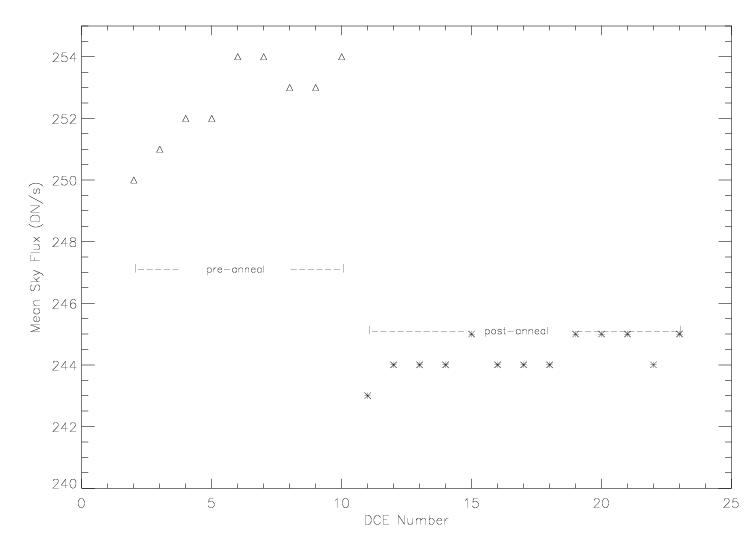
Principal:
Deputy:
Analyst:
AORKEYS:
Last Updated:
We converted the diagnostic data from the thermal anneal into temperatures and generated temperature plots. These data are compared to the temperature curves from previous anneals. These data are presented in the metatask writeup mips-2050.
We compared the 24um SUR data taken before and after the thermal anneal to look for changes in array behavior. The item of interest is the detector responsivity.
A Vrst analysis was performed on the Vrst data. In this test, the bias voltages for the 70um and 160um arrays are set to 0 mV, and then the Vrst voltages are adjusted between +5 mV and -5 mV relative to normal. A bright stim is turned on in manual mode during the test. The principle is that the array will produce a strong positive slope when positively biased and a strong negative slope when negatively biased, so the zero bias voltage point can be easily recognized. In practice, we calculate slope images and then look for this transition point.
filenames: mips_IER_7739136_gen_0_A24_Pukn_3s.fits
mips_IER_7739136_gen_(3-15)_A24_Pukn_3s.fits
DCE StarFlux SkyFlux FrameMean FrameMedian
2 35725. 250. 250.2 +/- 89.97 246.7
3 38122. 251. 252.3 +/- 82.29 249.3
4 36071. 252. 253.4 +/- 82.32 250.8
5 36093. 252. 254.3 +/- 91.09 250.4
6 35974. 254. 254. +/- 84.33 251.
7 35923. 254. 254.4 +/- 84.1 251.7
8 36175. 253. 254.4 +/- 84.45 251.5
9 36217. 253. 253.6 +/- 79.42 251.
10 36123. 254. 254.1 +/- 80.37 251.4
--- Thermal Anneal happened here ---
2 33497. 243. 245. +/- 60.72 243.9
4 33550. 244. 245.4 +/- 60.56 243.9
6 33684. 244. 246.1 +/- 62.29 244.7
8 33702. 244. 246.1 +/- 61.76 244.
10 34141. 245. 246.4 +/- 62.27 244.8
12 34669. 244. 246.4 +/- 62.48 244.4
14 34057. 244. 246.1 +/- 60.44 245.1
16 33815. 244. 246.6 +/- 61.23 245.
18 33666. 245. 246.6 +/- 61.62 245.3
20 33722. 245. 246.8 +/- 61.88 245.2
22 33713. 245. 246.8 +/- 62.4 245.3
24 33708. 244. 246.4 +/- 70.44 244.9
26 33698. 245. 247.4 +/- 63.38 245.4
The median star and sky fluxes are plotted below:


As mentioned in previous mips-992 writeups, the proper reference for the post-anneal data is the first data point from the pre-anneal data, which is the first DCE after a bias boost DCE. In this 23-hour long campaign, there seems to be a real change in Si detector response due to cosmic ray exposure. The growth in star flux is 6%, while the growth in sky levels is about 2.25%. No flatfielding was performed, so the sky flux change is the more realistic number.
The Vrst data are presented below. The filenames are MIPS.2/3.0007675648.00??.0001.01.mipl.fits. I ignored the last 72 frames in the 70um Vrst slope calculations. The 160um stim is brighter now than it used to be so I had to ignore 76 frames.
File Bias 70_1 70_2 70_3 70_4 70_5 70_6 70_7 70_8 160_1 160_2 160_3 160_4 03 Nom -260 -260 -300 -240 -300 -180 -240 -200 26 -51 2 12 04 +5 -350 -320 -340 -280 -330 -230 -320 -210 -321 -360 -201 -131 05 +4 -280 -250 -310 -280 -320 -270 -350 -320 -209 -281 -170 -88 06 +3 -220 -190 -270 -250 -240 -230 -260 -180 -129 -179 -81 -67 07 +2 -170 -150 -190 -220 -210 -200 -190 -180 -48 -130 -46 -20 08 +1 -80 -60 -140 -190 -140 -150 -170 -150 25 -60 2 14 09 Nom -50 20 -100 -100 -140 -110 -140 -120 83 -22 33 31:10 -1 30 120 -30 -60 -70 20 -90 -110 155 15 135 65 11 -2 90 180 50 -10 -40 -30 -40 -50 248 52 117: 101 12 -3 140 210 80 40 30 40 0 -40 376 104 178 143 13 -4 220 290 160 30 140 100 30 -10 478 149 234: 206 14 -5 250 300 240 80 180 160 70 20 576: 234 333 248:15 Nom -150 -110 -210 -230 -270 -210 -260 -200 82 -16 43 35: Vrst -0.5 +0.25 -1.5 -2.25 -2.5 -2.5 -3.0 -4.5 +1.5 -0.5 +1.0 +1.5 DAC Counts -2 +1 -6 -9 -10 -10 -12 -18 +6 -2 4 +6 DAC NOM 90E 8F7 910 8E7 916 90B 920 905 97D 91C 91C 913 New DAC 90C 8F8 90A 8DE 90C 901 914 8F3 983 91A 920 919